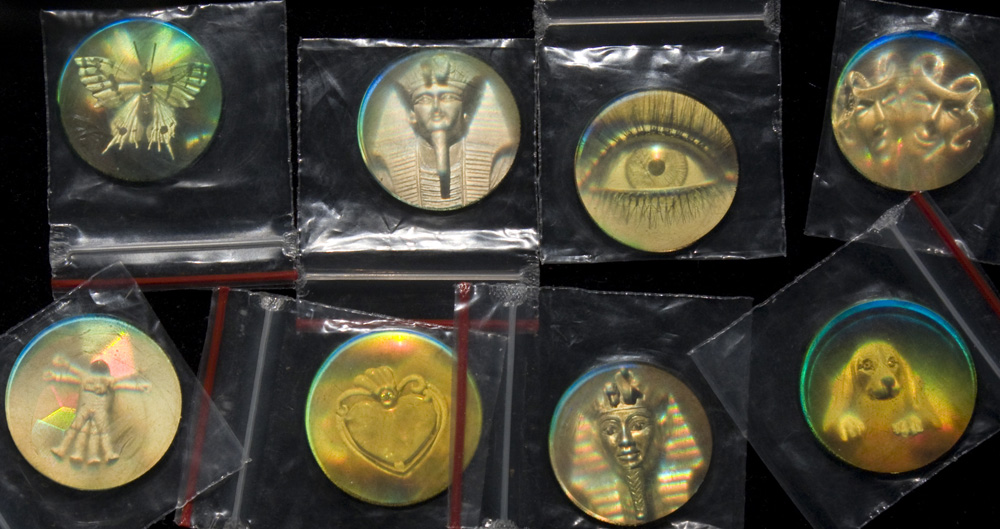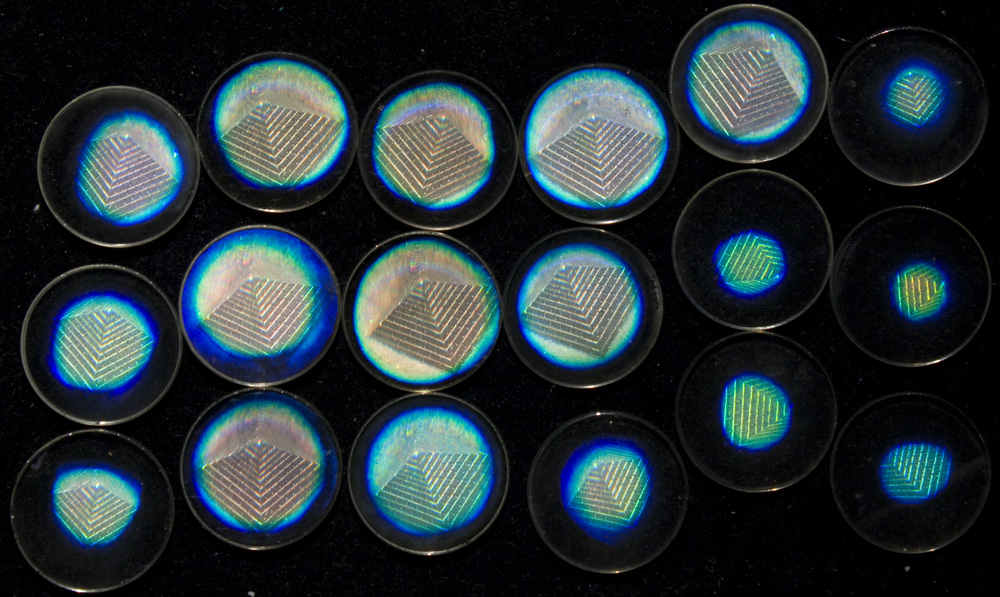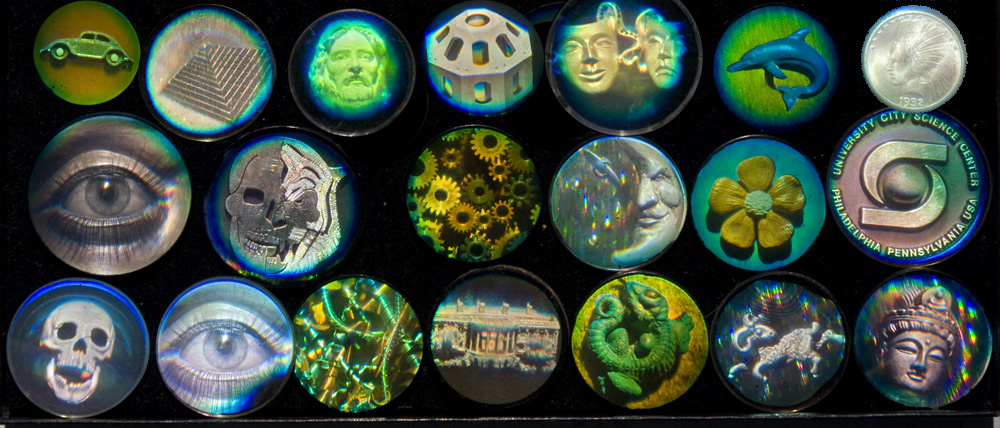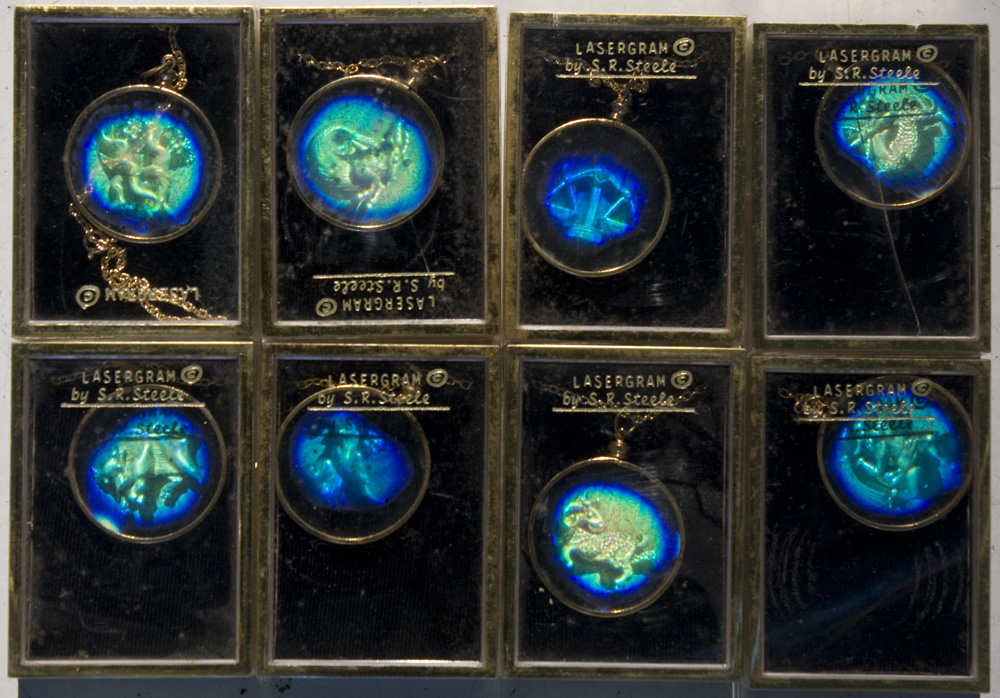

Disambiguation:
This page discusses types of holograms generically termed "Dichromates" by the holographic stock image trade. They receive this moniker from the material they are recorded in, a gelatin layer made light sensitive by the addition of a chromium compound, rather than a silver salt as used in traditional holography. This DiChromated Gelatin process is described in detail on the page called DCG; the process itself will be refered to on this site as DCG, as opposed to the end product, a dichromate.
Birth of an Industry:
The dude most responsible for the marketing of dichromates is Rich Rallison; his autobiography, "Dichromates come from Jello" gives great insights into the birth of this medium. Others soon followed, like Don Broadbent in Southern California, Fred Unterseher in Northern California, Gary Cullen of Holocrafts further up the West Coast in British Columbia, Canada; Portson out of Kansas City, MO; and August Muth of Santa Fe, New Mexico, etc. Their main stock in trade was jewelry, mainly pendants for necklaces, or earrings or belt buckles The most common format of dichromates are 38 millimeter (1 1/2 inches) diameter pendants, as this shape would then fit into readily available jewelry fittings and belt buckles.
Who knows how many millions of these were made to be worn as the height of New Wave fashion?
A Small Technical Discussion
Is necessary to understand the images downstream. The DiChromated Gelatin process is popular with its practitioners as it costs next to nothing to coat a piece of glass with gelatin doped with potassium dichromate. The cheapness of the material is offset by it need for blue photons to make it work, which are of course the most expensive to produce. The labs where most of these images were shot were equipped with monster Argon lasers, which were soaking up 208 Volt 3 phase current at about 50 Amps per phase, making Commonwealth Edison happy, plus that kind of current density inside the laser tube requires that it be water-cooled, yet more money going to utilities. The materials are inexpensive, the overhead is high.
The processing of the coating involves nothing more than a common photographic darkroom chemical, Kodak Rapid Fixer (or equivalent), water, and graduated baths of isopropyl alcohol with percentages of water to alcohol from 50% to 70% to 100%, followed by a blow drying to evaporate the alcohol. By controlling these variables the color of the final hologram can be the same as the laser used to make it, or shrunk or grown to a longer wavelength, usually shifted to a golden color to sort of look like jewlery, or even designed to replay in many colors at once. These are known technically as a broadband hologram but the image to a viewer looks white, making it apparently brighter than most other holographic recording materials.
But the major issue in the production of dichromates is in the sealing of the coating from the environment. Water is used in processing to rearrange the layer into a structure of dichromate hardened gelatin and air voids that resembles the interference pattern generated in the holographic recording. If the gelatin were to be re-wetted, these felt-like layers would collapse onto each other, first changing the holograpm's reconstruction color to shorter wavelengths, ending up with a blue image, then an invisible ultraviolet one, and then nothing at all except for 2 discs of glass glued together.This will be noticed in the following images; nothing at the edges, a blue ring, then what's left of the image in the center, the furthest a pesky H2O molecule has to travel to ruin your day. Most modern day practioners claim that they have solved this problem, but so did those holographers who made the following images below decades ago! If you are a dichromate collector, enjoy them while you can still see them! There doesn't seem to be any way of rejuvenating them!
Here are a batch of Pyramid dichromates from International Dichromate, the color as they came from the factory was an orange-golden color to represent sand, but only a few examples have that hue remaining in the center, and as the humidity travels in from the edge, the color shrinks from orange in the center to green to blue to ultraviolet along the radius to the circumference.

The header image is composed of fairly pristine pieces from the lab of Holocrafts outside of Vancouver; below are images from a variety of sources.

Here is what is left of a complete set of Zodiac holograms, produced by International Dikrotek, but marketed by our local Man of Steel, not Super-Duper-Man, but Stanley Steele. Presentation is everything, and he had nice jewel cases embossed with his name and copyrighted trademark!

And to think that I worked my way through holography school selling these!.